宏观经济学 Intermediate_Macroeconomics_Lecture14
中级宏观经济学(英文版第3章)Intermediate Macroeconomics
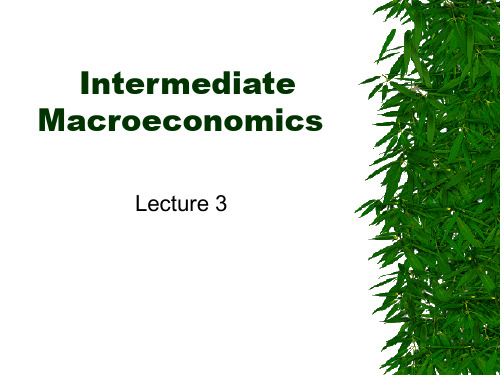
CPI v.s.GDP deflator
CPI may overstate inflation (sorry! not always )
When it really overstates inflation, comparing to the GDP deflator, we should look for reasons from where it differs from the GDP deflator, right?
What is the accounting profit? What is the economic profit? What is the intuition for their difference?
Thanks for your patience!
Please come to me or email me your questions whenever you feel necessary
2 people 2 spades
……
L or K MPL or MPK L or K
Production Function
Decreasing Returns to Scale (DRS)
e.g. Y L K
Intuition:
Q
Y
1 office 1 worker
1 office 2 workers
My office hours are Monday 10:30-12:00. Door is open to everyone! ☺
Let’s get better in Macroeconomics together!
macroeconomics名词解释
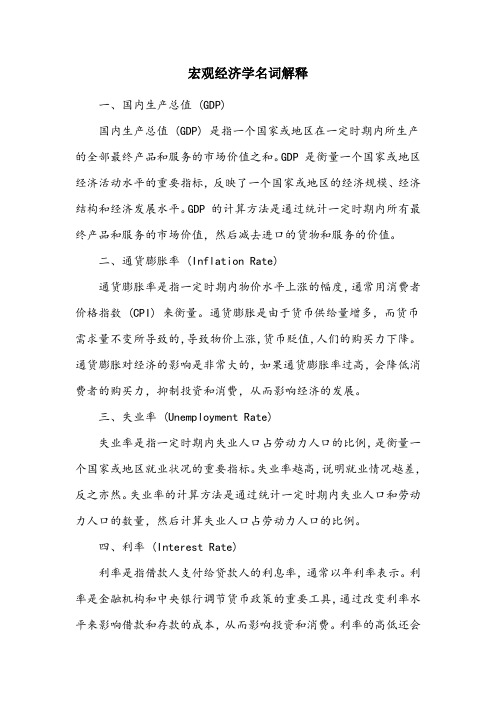
宏观经济学名词解释
一、国内生产总值 (GDP)
国内生产总值 (GDP) 是指一个国家或地区在一定时期内所生产的全部最终产品和服务的市场价值之和。
GDP 是衡量一个国家或地区经济活动水平的重要指标,反映了一个国家或地区的经济规模、经济结构和经济发展水平。
GDP 的计算方法是通过统计一定时期内所有最终产品和服务的市场价值,然后减去进口的货物和服务的价值。
二、通货膨胀率 (Inflation Rate)
通货膨胀率是指一定时期内物价水平上涨的幅度,通常用消费者价格指数 (CPI) 来衡量。
通货膨胀是由于货币供给量增多,而货币需求量不变所导致的,导致物价上涨,货币贬值,人们的购买力下降。
通货膨胀对经济的影响是非常大的,如果通货膨胀率过高,会降低消费者的购买力,抑制投资和消费,从而影响经济的发展。
三、失业率 (Unemployment Rate)
失业率是指一定时期内失业人口占劳动力人口的比例,是衡量一个国家或地区就业状况的重要指标。
失业率越高,说明就业情况越差,反之亦然。
失业率的计算方法是通过统计一定时期内失业人口和劳动力人口的数量,然后计算失业人口占劳动力人口的比例。
四、利率 (Interest Rate)
利率是指借款人支付给贷款人的利息率,通常以年利率表示。
利率是金融机构和中央银行调节货币政策的重要工具,通过改变利率水平来影响借款和存款的成本,从而影响投资和消费。
利率的高低还会
影响货币的供求关系,进而对汇率产生影响。
宏观经济学 Intermediate_Macroeconomics_Lecture2
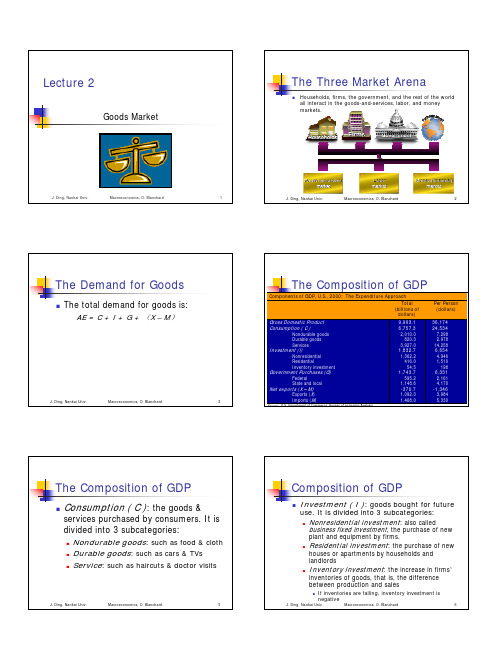
The Composition of GDP
The Composition of GDP
Government Spending ( G ): the
goods and services bought by federal, state, and local government.
It does not include transfer payments to individuals, such as Social Security and welfare
If inventories are falling, inventory investment is negative
Macroeconomics, O. Blanchard 6
J. Ding, Nankai Univ.
Macroeconomics, O. Blanchard
5
J. Ding, Nankai Univ.
I =I
income, interest rate, profit expectation of the investment, the technology, and etc.
Planed investment here is an exogenous Variables:
Endogenous: variables that depend on other variables within the model Exogenous: variables that are not explained within the model
Marginal Propensity to Consume (MPC) is between 0 & 1, Average Propensity to Consume (APC) falls as income rises, Income is the primary determinant of C
中级宏观经济学讲义12
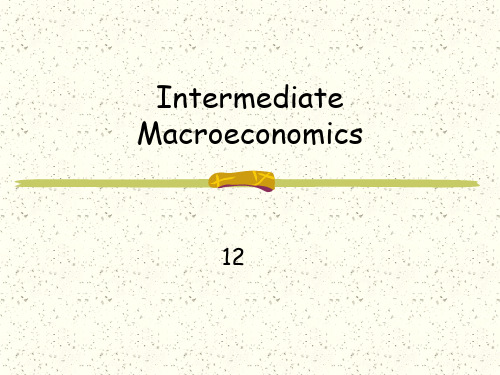
Con: 若不工作=不愿工作,失业率不应变化
Pro: 工资不合意or失业保障 失业率变化不说明任何问题
Real Business Cycle Theory
2. 技术冲击是引起经济波动的源泉之一
为何小菜单成本会导致大商业周期?
小菜单成本与大商业周期
单个企业降价,不仅利于自己企业产品的销售。 对社会所有企业也有利。
p↓ 平均P↓ 对所有企业产品的需求↑ (总需求的外部性, 类似教育)
单个企业降价具有正外部性 每个企业都会不降价或降价不够
效率工资理论
工资定在使工人的努力程度最大(效率工资)时, 才能达到企业的利润最大化
高就业高产出优于低产出低就业
当可能出现多个Nash均衡时,社会不一 定能达到最优的均衡
协调失灵导致衰退
Firm1 低产出
高产出
低产出 Firm2
高产出
Firm 1 --- $30 Firm 1 --- $10 Firm 2 --- $30 Firm 2 --- $70
Firm 1 --- $70 Firm 1 --- $100 Firm 2 --- $10 Firm 2 --- $100
捕鱼(就业&消费); 织网(投资)
冲击1: 鱼群游过小岛 生产率提高 就业增加
冲击2: 暴风雨 就业减少 消费和投资下降
Real Business Cycle Theory
消费、投资、就业、产出和生产率的波动都
是个人对环境变化自然合意的反应。
经济波动与货币政策、市场失灵和粘性价格 无关
Real Business Cycle Theory
宏观经济学原理第七版曼昆名词解释带英文
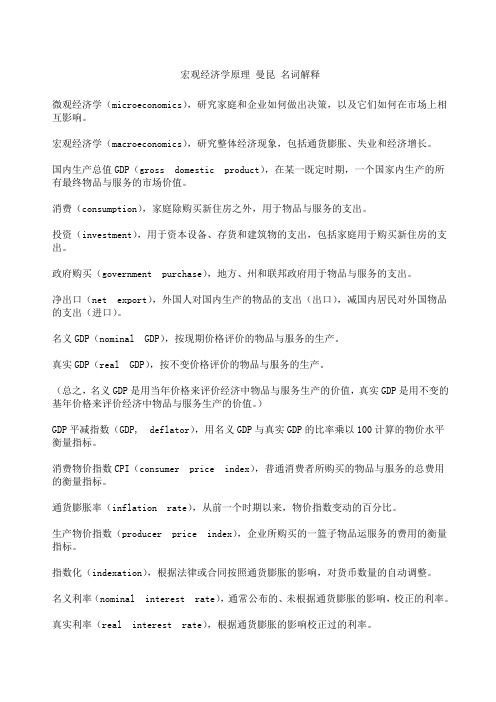
宏观经济学原理曼昆名词解释微观经济学(microeconomics),研究家庭和企业如何做出决策,以及它们如何在市场上相互影响。
宏观经济学(macroeconomics),研究整体经济现象,包括通货膨胀、失业和经济增长。
国内生产总值GDP(gross domestic product),在某一既定时期,一个国家内生产的所有最终物品与服务的市场价值。
消费(consumption),家庭除购买新住房之外,用于物品与服务的支出。
投资(investment),用于资本设备、存货和建筑物的支出,包括家庭用于购买新住房的支出。
政府购买(government purchase),地方、州和联邦政府用于物品与服务的支出。
净出口(net export),外国人对国内生产的物品的支出(出口),减国内居民对外国物品的支出(进口)。
名义GDP(nominal GDP),按现期价格评价的物品与服务的生产。
真实GDP(real GDP),按不变价格评价的物品与服务的生产。
(总之,名义GDP是用当年价格来评价经济中物品与服务生产的价值,真实GDP是用不变的基年价格来评价经济中物品与服务生产的价值。
)GDP平减指数(GDP, deflator),用名义GDP与真实GDP的比率乘以100计算的物价水平衡量指标。
消费物价指数CPI(consumer price index),普通消费者所购买的物品与服务的总费用的衡量指标。
通货膨胀率(inflation rate),从前一个时期以来,物价指数变动的百分比。
生产物价指数(producer price index),企业所购买的一篮子物品运服务的费用的衡量指标。
指数化(indexation),根据法律或合同按照通货膨胀的影响,对货币数量的自动调整。
名义利率(nominal interest rate),通常公布的、未根据通货膨胀的影响,校正的利率。
真实利率(real interest rate),根据通货膨胀的影响校正过的利率。
中级宏观经济学课程教学大纲

中级宏观经济学课程教学大纲课程名称:中级宏观经济学/ Intermediate Macroeconomics课程代码:06236602课程类型:专业/必修总学时数:48学分:3先修课程:(初级)微观经济学、(初级)宏观经济学、微积分、概率统计开课单位:经济管理学院适用专业:经济学一、课程的性质、目的和任务《中级宏观经济学》是经济学专业学生在高年级阶段要学习的专业基础拓展课程之一。
本课程是在(初级)宏观经济学的基础上,通过模型与实际案例相结合的方式向学生介绍中级水平的宏观经济学的主要理论和相关经济政策。
该课程将使学生进一步了解西方主流宏观经济理论及其分析方法,提高对宏观经济现象的认识和分析能力,尝试并运用所学分析工具分析当前国际和国内的一些宏观经济问题;同时为学习其他经管类课程提供宏观经济理论方面的支持和帮助。
二、教学内容及教学基本要求1.导论及宏观经济的数据:了解宏观经济学关注的问题及其数据;理解宏观经济学的研究方法;掌握宏观经济学的研究内容、研究方法、GDP、CPI、失业率的衡量。
教学重点与难点:宏观经济学、真实GDP,通货膨胀率,失业率,市场出清,灵活变动的价格及粘性价格,GDP, CPI, 国民收入核算,劳动力,劳动力参与率,奥肯定律,GDP 平减指数2.长期中的经济:了解价格具有伸缩性的长期中的经济现象及理论;理解国民收入的基本模型、劳动市场和自然失业率、货币与物价水平、以及开放经济的宏观经济学;掌握生产函数、物品和劳务需求的决定、消费、需求、政府购买、物品和劳务的供求平衡,失业的类型、工资刚性、效率工资,货币的职能、类型、货币数量论、名义利率与实际利率、通货膨胀的社会成本、超级通货膨胀、古典二分法,小型开放经济中的储蓄与投资、名义与实际汇率。
教学重点与难点:规模收益不变、真实工资、边际产品、消费函数、边际消费倾向、挤出、通货膨胀、货币供给、货币政策、中央银行、公开市场操作、货币交易速度,货币需求函数、货币数量论、名以及真实利率、费雪方程、古典二分法,货币中性、净出口、资本净流出、名义汇率、真实汇率、购买力平价、自然失业率、摩擦失业、结构失业、工资刚性、效率工资。
宏观经济学 Intermediate_Macroeconomics_Lecture9

J. Ding, Nankai Univ.
Macroeconomics, O. Blanchard
1
J. Ding, Nankai Univ.
Interactions Between Output and Capital
The Effects of Capital on Output
Under constant returns to scale, we can write the relation between output and capital per K worker as follows: Y = F ,1
N N
Then:
Y K = f N N
7 J. Ding, Nankai Univ. Macroeconomics, O. Blanchard 8
J. Ding, Nankai Univ.
Macroeconomics, O. Blanchard
The Equation of Motion for k
The Equation of Motion for k
J. Ding, Nankai Univ. Macroeconomics, O. Blanchard 14
Steady-State Capital and Output
kt +1 − kt = sf (kt ) − δkt
Moving Toward the Steady State
Given the steady state of capital per worker (k*),
The higher output, the higher saving, and so the higher investment.
宏观经济学 Intermediate_Macroeconomics_Lecture4
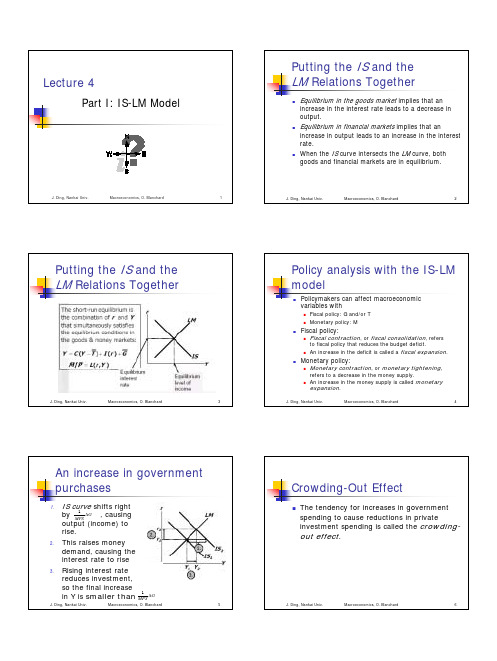
Hold M constant Hold r constant Hold Y constant
In each case, the effects of the ∆G are different:
Macroeconomics, O. Blanchard 11
If Congress raises G, the IS curve shifts right If Fed holds M constant, then LM curve does not shift. Results:
At the end of 1992, Clinton was elected president:
The federal budget deficit was 4.5% of the GDP The U.S. economy was just coming out of the 1990-1991 recession
− 4.5 − 3.8 − 2.7 − 2.4 − 1.4 − 0.3
If Congress raises G, the IS curve shifts right To keep Y constant, Fed reduces M to shift LM curve left. Results:
∆Y = 0 ∆r = r3 −r 1
Macroeconomics, O. Blanchard 14
Monetary policy:
refers to a decrease in the money supply. An increase in the money supply is called monetary expansion.
宏观经济学Intermediate Macroeconomics(英文版)

u
= GDP1 GDP0 *100 GDP0
= change in unemployment rate = u1 u0
The Data of Macroeconomics
Okun’s Law implies two thY Y
What Determines the Total Production of G&S
Factor supply
Q of factor
Factor price
Firms’ Problem
Maximize profit Profit = Revenue – Cost Profit = R- C R = P * Q = P * Y = P * F(K,L) C = Labor Cost + Capital Cost C=w*L+r*K Profit = P * F(K,L) – w*L – r*K
goods are equal
Circular Flow
Markets for Factors of Production income
P.S. Financial Markets
Households
G.D.
T
Government
I
C
G.P.
Markets for Goods and Services
What Determines the Total Production of G & S
Assumptions
i. Fixed amount of input
K
K
,
LL
宏观经济学(Macroeconomics)
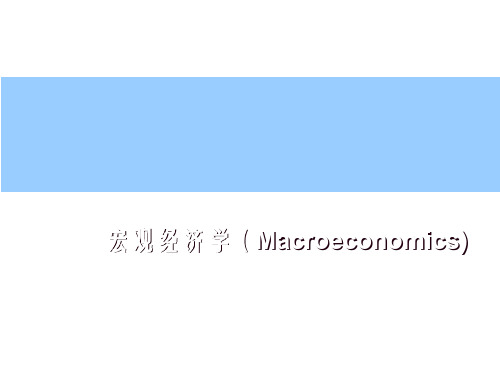
• 中央银行的再贴现率上升商业银行向中 央银行借款的成本上升商业银行自己多
留准备金实际准备率上升
6.1.4 经济持续稳定增长
• 是指在一个特定时期内经济社会所生产的人 均产量和人均收入的持续增长
• 一般用实际国内生产总值年均增长率来衡量 • 持续、稳定、长期的增长是经济社会所追求
的理想状态
6.1.5 国际收支平衡
• 国际收支平衡对开放型经济国家至关重要 • 国际收支会影响一个国家的就业、物价和经
6.2.8 拉弗曲线(属于供给学派理论)
• 一般来说,税率越高,政府的税收就越多,所以 提高税率可以增加政府的收入
• 但是,税率的提高超过一定的限度,企业的经营 成本提高,它们会减少投资,甚至退出这个地区 乃至国家的投资,从而造成政府征税基础的缩小 ,政府税收的总量因此减少
• 描绘这种税收与税率关系的曲线叫做拉弗曲线
• 充分就业预算盈余:是指既定的政府预算在充分就 业的国民收入水平上所产生的政府预算盈余。(为 使预算盈余成为判断财政政策的扩张或紧缩而提出 )
• 充分就业预算盈余:BS﹡=tY﹡-G-TR • 实际预算盈余: BS=tY-G-TR
充分就业预算盈余
• 如果:Y﹡<Y,则, BS﹡ < BS • 如果:Y﹡>Y,则, BS﹡ > BS • 充分就业预算盈余增加或赤字减少,财政政策紧缩 • 充分就业预算盈余减少或赤字增加,财政政策扩张 • 意义:
– 政策乘数大小是多少? – 政策时滞是多长? – 挤出效应有多大? – 不确定性如何排除?
6.2.4 国家预算
• 预算赤字和预算盈余 • 预算赤字:收<支;预算盈余:收>支 • ---年度平衡预算 • ---周期平衡预算(瑞典预算,补偿性财政政策) • 把原来争取年度预算平衡拓展成实现每个经济周期的
macro- model(宏观经济学中的经济模型解说)

1 Y f( ) P
P Y
AS—AD模型
• 均衡产出(Y)和价格水平(P)是内生变量, 政府支出,名义货币供应量、劳动力人数是外 生变量。当产品市场、货币市场和劳动力市场 同时达到均衡时(两个方程联立求解),即可 得到两个内生变量Y与P解。
Y P P (1 u) F (1 , z ) L
e
W : 名义工资 u:失业率 P P
z:the catchallvar iable
AD关系由IS-LM模型推导而来
Y C (Y T ) I (Y , i) G
M YL(i) P
解析国民收入决定模型
• 宏观经济模型围绕着国民收入的决定展开, 即把国民收入作为内生变量,研究它由哪 些可调控的外生变量决定的。 • 为了降低复杂性,初等的宏观经济模型中 的变量之间的关系都以线性形式出现。
产品市场均衡(IS模型)
• 首先,从产品市场入手,把政府支出和 投资作为外生变量,形成IS模型,即收 入——支出模型 。该模型由三个方程组 成,包含三个内生变量(Y,C,M)和 三个外生变量。
• 经济学研究的基本前提是指所有的经济 学研究得以进行的必要条件。前提和假 设在这一点上有共同之处。但前提是所 有研究者明确或隐含接受和认可的,而 假设则未必。在相同的前提下,可以有 不同的假设。不同的经济理论可以有共 同的前提,但一定有不同的假设。经济 学研究的基本前提,是经济学得以存在 的理由和意义所在。
AS-AD模型
• 将政府支出、货币供应量、劳动力人口 作为外生变量,将价格水平、产出、消 费、进口、投资、利率、货币需求、失 业率、名义工资作为内生变量,将产品 市场、货币市场、劳动力市场结合在一 起,建立起三个市场同时达到均衡时的 AS-AD模型。
宏观经济学Microeconomics

两部门国民收入流量循环图
生产要素市场
Y
工资,租金,利息,利润
家 庭 储蓄 金融机构 投资 企 业
S
I
购买各种产品和劳务
C 商品市场
总收入
C+S =Y= C+I
总支出
三部门国民收入流量循环图
TR TA1
政府 Y
G TA2
总支出 总收入
家庭 S
金融机构 I
C C+S+(TA-TR)= Y = C+I+G
S = I(r)
0
I(r)
S
I,S
七.储蓄的变动: 财政政策的影响
1) 政府购买的增加 2) 税收减少
八.投资需求的变动
r S2 S1
r
S
r
r2
r2
r1
I(r) r1
0
I,S 0
I2 r2 I1 r1 I.S 0
S(r)
I2 I1
I1 I2 I.S
第4章 经济增长 I (索洛增长模型)
第一节 资本积累
版权所有
谢绝拷贝
宏观经济学 Macroeconomics
主讲: 仲晓东
淮阴工学院 经济教研室 E-mail: zxd71831@ Tel: 3591045
第1章 宏观经济学的科学
第一 节 宏观经济学家研究什么
Y = F(L,N,K,H)
总产出=总投入
总支出=总收入
总需求=总供给
1. 宏观经济学要解决的四大问题 1) 稳定物价 2) 充分就业 3) 平衡国际收支 4) 持续经济增长
I+G+NX = S+T
(NX为净出口,T为净税收.)
宏观经济学课后题答案

第1章宏观经济学导论:习题答案一、名词解释1.宏观经济学(Macroeconomics),也叫做总量经济学,它是通过对整个社会经济总量决定及其变化的科学研究,来揭示和描述稀缺资源配置、国民收入变化以及宏观经济增长和发展规律的科学。
其研究所涉及的主要内容是整个社会的价格水平、总产量、就业水平和其他经济总量的决定。
2.凯恩斯学派(Keynesian)是最初由凯恩斯等人开创的、二战以后在欧美等发达国家发展起来、并迅速得到世界上大多数市场经济国家认可与推崇的宏观经济学学派。
凯恩斯开创的宏观经济理论在20世纪五六十年代的美国获得最大发展。
主要代表有凯恩斯、保罗·萨缪尔森(Paul A.Samuelson)、詹姆斯·托宾(James Tobin)、罗伯特·索洛(Robert Solow)等。
3.理性预期学派(Rational Expectation School)是在1970年代在美国出现的一个经济学流派。
相对“适应性预期”而言,理性预期是指人们预先充分掌握了一切可以利用的信息做出的预期。
人们参照过去历史提供的所有知识并加以有效利用,并经过周密的思考之后,才做出的与有关经济理论相一致的“理性预期”。
4.货币主义学派(Monetary school)是1950-1960年代在美国出现的经济学流派,亦称货币主义,其创始人为美国芝加哥大学教授弗里德曼。
货币学派的政策主张主要有:坚持经济自由主义,反对国家过多干预;认为“货币最重要”;主张实施“单一规则”即固定货币供应增长率的货币政策。
5.供给学派(supply-side school)是1970年代在美国兴起的一个经济学流派。
该学派强调经济的供给方面,认为需求会自动适应供给变化。
其政策主张有:崇尚“供给自创需求”的萨伊定律;反对政府过多的干预;应通过减税刺激投资,增加供给;反对过多社会福利,反对通货膨胀,竭力主张大幅度减税等。
6.新自由主义(Neo-liberalism)狭义新自由主义主要是指以出生于奥地利的经济学家和思想家——哈耶克为代表的新自由主义。
宏观经济学 Intermediate_Macroeconomics_Lecture12
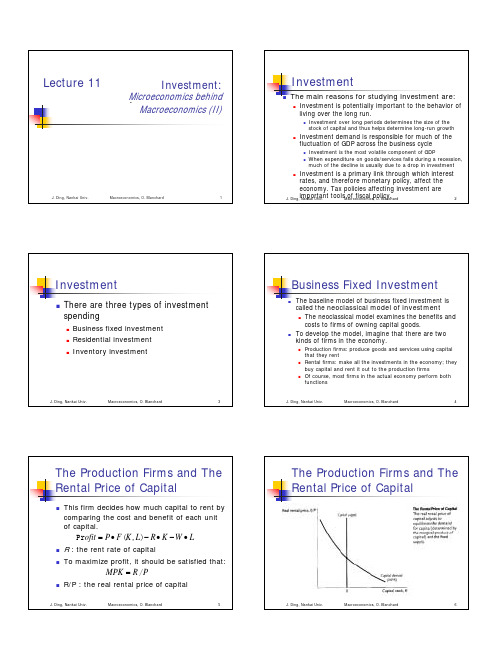
J. Ding, Nankai Univ.Macroeconomics, O. Blanchard 1Lecture 11.Investment:Microeconomics behind Macroeconomics (II)J. Ding, Nankai Univ.Macroeconomics, O. Blanchard 2InvestmentThe main reasons for studying investment are:Investment is potentially important to the behavior of living over the long run.Investment over long periods determines the size of the stock of capital and thus helps determine long-run growthInvestment demand is responsible for much of the fluctuation of GDP across the business cycleInvestment is the most volatile component of GDPWhen expenditure on goods/services falls during a recession, much of the decline is usually due to a drop in investmentInvestment is a primary link through which interest rates, and therefore monetary policy, affect the economy. Tax policies affecting investment are important tools of fiscal policy.J. Ding, Nankai Univ.Macroeconomics, O. Blanchard 3InvestmentThere are three types of investmentspendingBusiness fixed investment Residential investmentInventory investmentJ. Ding, Nankai Univ.Macroeconomics, O. Blanchard4Business Fixed InvestmentThe baseline model of business fixed investment is called the neoclassical model of investmentThe neoclassical model examines the benefits and costs to firms of owning capital goods.To develop the model, imagine that there are two kinds of firms in the economy.Production firms: produce goods and services using capital that they rentRental firms: make all the investments in the economy; they buy capital and rent it out to the production firmsOf course, most firms in the actual economy perform both functionsThe Production Firms and The Rental Price of CapitalThis firm decides how much capital to rent by comparing the cost and benefit of each unit of capital.R : the rent rate of capitalTo maximize profit, it should be satisfied that:R/P : the real rental price of capitalL W K R L K F P ofit •−•−•=),(Pr P R MPK /=The Production Firms and The Rental Price of CapitalJ. Ding, Nankai Univ.Macroeconomics, O. Blanchard7The Production Firms and The Rental Price of CapitalFor example, the Cobb-Douglas production function is:In equilibrium:This expression identifies the variables thatdetermine the real rental price:The lower the stock of capital K , the higher the real rental price of capitalThe greater the amount of labor employed L , the higher the real rental price of capitalThe better the technology A , the higher the real rental price of capitalαα−=1L AK Y αα−=1)(K L A P R J. Ding, Nankai Univ.Macroeconomics, O. Blanchard 8The Rental Firms and The Cost of CapitalThe benefit of owning capital is the revenue from renting it to the production firms.The rental firm receives the real rental price of capital R/P for each unit of capital it owns and rents out.J. Ding, Nankai Univ.Macroeconomics, O. Blanchard9The Rental Firms and The Cost of CapitalThe cost of owning capital is more complex. For each period of time that it rents out a unit of capital, the rental firm bears three costs:When a rental firm borrows to buy a unit of capital,which it intends to rent out, it must pay interest on the loan: Where, is the purchase price of a unit of capitalis the nominal interest rateWhile the rental firm is renting out the capital, the price of capital can change. The cost of this loss or gain isWhile the capital is rented out, it suffers depreciation: KP ∆−KP δKiP KP i J. Ding, Nankai Univ.Macroeconomics, O. Blanchard10The Rental Firms and The Cost of CapitalThe total cost of renting out a unit of capital for one period is therefore:We assume that the price of capital goods rises withthe prices of other goods. In this case, equalsthe overall rate inflation , thereforeBecause equals the real interest rate r , so:Finally, the real cost of capital ( the cost of buying and renting out a unit of capital measured in units of the economy ’s output) is :)/(δδ+∆−=+∆−=K K K K K K P P i P P P iP tal CostOfCapi K K P P /∆ππ−i )(δ+=r P tal CostOfCapi K ))(/(Re δ+=r P P pital alCostOfCa K )(δπ+−=i P tal CostOfCapi K The Rental Firms and The Determinants of InvestmentNow consider a rental firm ’s decision about whether to increase or decrease its capital stock. The real profit per unit of capital isThe change in the capital stock, called netinvestment depends on the incentive to invest:Where I n [ ] is the function showing how much net investment responds to the incentive to invest.Total spending on business fixed investment is the sum of net investment and the replacement of depreciated capital. The investment function is))(/())(/(/Pr δδ+−=+−=r P P MPK r P P P R ofit K K )])(/([δ+−=∆r P P MPK I K K n The Rental Firms and The Determinants of InvestmentJ. Ding, Nankai Univ.Macroeconomics, O. Blanchard 13The Rental Firms and The Determinants of InvestmentThe model shows why investment depends on the interest rate.The model also shows what causes the investment schedule to shift.Any event that raises the MPK increases the profitability of investment and causes the investment schedule to shift outward.J. Ding, Nankai Univ.Macroeconomics, O. Blanchard 14Difficulties with the Baseline ModelThis baseline model has at least one failings as a description of actual behavior:This model does not identify any mechanism through which expectations affect investment demand.In practice, expectations about demand and costs are central to investment decisionsJ. Ding, Nankai Univ.Macroeconomics, O. Blanchard15Investment and The Stock MarketMany economists see a link between fluctuations in investment and fluctuations in the stock marketStock prices tend to be high when firms have many opportunities for profitable investmentbecause these opportunities mean higher future income for the shareholdersThus, stock prices reflect the incentives to investThe Nobel Prize winner James Tobin proposed that firms base their investment decisions on the ratio of the market value of installed capital to itsreplacement cost, which is now called Tobin ’s qJames Tobin, “A General Equilibrium Approach to Monetary Theory ”, Journal of Money, Credit, and Banking, 1969J. Ding, Nankai Univ.Macroeconomics, O. Blanchard16Investment and The Stock MarketTobin ’s q :the ratio of the market value of installed capital to its replacement costNumerator : the value of the capital as determined by the stock marketDenominator : the price of the capital if it were purchased todaythe ratio of the market value of corporations (share price times number of shares) to the value of the capital stock of corporationsThe stock price tells firms how much the stock market values each unit of capital already in place; thus, the willingness to pay for one more unit.llledCapita ostOfInsta placementC edCapital eOfInstall MarketValu q Re =Investment and The Stock MarketThis ratio reflects the current and expected future profitability of capital.The higher the profitability, the higher is qThe higher is q , the greater is themarket value of installed capital relative to its replacement cost, and the greater is the incentive to invest.Investment and The Stock MarketAn alternative way of expressing the neoclassical model is to state that investment depends on Tobin ’sqFumio Hayashi, “Tobin ’s Marginal q and Average q: a Neoclassical Approach ”,Econometrica, 1982The q theory of investment and the neoclassical model of investment are closely relatedRemember that Tobin ’s q depends on current and future expected profits from installed capitalIf MPK exceeds the cost of capital, then the production firms are earning profit on their installed capital. These profits make the rental firms desirable to own, which raises the market value of these rental firms ’s stock, implying a high value of qJ. Ding, Nankai Univ.Macroeconomics, O. Blanchard19Residential InvestmentResidential investment includes the purchase of new housing bothby people who plan to live in it themselves, andby landlords who plan to rent it to othersTo keep things simple, we imagine that all housing is owner-occupiedThere are two parts to the model.The market for the existing stock of houses determines the equilibrium housing priceThe housing price determines the flow of residential investmentJ. Ding, Nankai Univ.Macroeconomics, O. Blanchard20Residential InvestmentJ. Ding, Nankai Univ.Macroeconomics, O. Blanchard21Residential InvestmentThe relative price of housing plays much the same role for residential investment as Tobin ’q does for business fixed investmentAccording to the q theory, business fixed investment depends on the market price ofinstalled capital relative to its replacement cost; this relative price, in turn, depends on the expected profits from owning installed capital.According to this housing market model,residential investment depends on the relative price of housing, which depends on the imputed rent that individuals expect to receive from their housing.J. Ding, Nankai Univ.Macroeconomics, O. Blanchard22Residential InvestmentReal interest rate -one important determinant of housing demand:If people take out loans –mortgages –to buy their homes, then the interest rate is the cost of the loanEven if people do not have to borrow to purchase a home, the interest rate is the opportunity cost of holding their wealth in housingA reduction in the interest rate raises housing demand, housing prices, and residential investment.Residential InvestmentInventory InvestmentSome reasons for holding inventories:Production smoothing: to smooth the level of production over time.Rather than adjusting production to match the fluctuations in sales, the firm may find it cheaper to produce goods at a steady rate.Using them as a factor of productionHolding inventories may allow a firm to operate more efficientlyE.g.: manufacturing firms keep inventories of spare parts, to reduce the time that the assembly line is shut down when a machine breaksE.g.: retail stores, can sell merchandise more effectively if they have goods on hand to show to customers.J. Ding, Nankai Univ.Macroeconomics, O. Blanchard 25Inventory InvestmentSome reasons for holding inventories:Stock-out avoidance: to avoid running out of goods when sales are unexpectedly highIf demand exceeds production and there are noinventories, the good will be out of stock for a period, and the firm will lose sales and profitWork in processWhen a product is only partly completed, its components are counted as part of a firm ’s inventoryJ. Ding, Nankai Univ.Macroeconomics, O. Blanchard26Inventory InvestmentThe accelerator model is one simple model of inventories :Assume that firms hold a stock of inventories that is proportional to the firms ’level of output.Predict that inventory investment is proportional to the change in output.The model says that the stock of inventories depends on the level of GDP, and inventory investment depends on the change in GDP.YN β=YN I ∆=∆=βJ. Ding, Nankai Univ.Macroeconomics, O. Blanchard27Inventory InvestmentHence, inventory investment depends on whether the economy is speeding up or slowing down, i.e., the “acceleration ”of production.Inventory investment also depends on the real interest rateThe real interest rate measures the opportunity cost of holding inventoriesWhen the real interest rate rises, holdinginventories becomes more costly, so rational firms try to reduce their stock.。
宏观专业术语中英对照及其含义分析解析

宏观经济学专业术语1.Macroeconomics 宏观经济学对经济总体行为的分析,主要研究产出.收入.价格水平.对外贸易.失业和其他总体经济变量。
(参见微观经济学,microeconomics)。
2. Final goods 最终产品旨在最终使用而非转卖或进一步加工的商品。
3.Flow vs. stock 流量与存量流量是指,带有时间跨度或曰在一个时段上所累积变动的量(好比通过一个河段的水流)。
存量则指,在某一个时点上某一变量的量值(如同湖中所盛的水)。
收人代表每一年的美元流入数,因此是一个流量。
而到1998年12月为止某人的财富则是一个存量。
4. Intermediate goods 中间产品经过一些制造或加工过程,但还没有达到最终产品阶段的产品。
例如,钢铁和棉纱就是中间产品。
Income 收入5.个人或国家一段时期内(通常为一年)所新增的工资.利息.红利和其他进帐的流量。
6.Personal income 个人收入衡量税收抵扣前收入的一个指标,确切地说,等于可支配个人收入加上净税收。
7.Personal saving 个人储蓄收人中没有被消费的部分,是个人可支配收入与消费之间的差额。
8.Personal savings rate 个人储蓄率和National savings rate 国民储蓄率以百分比形式表示的个人储蓄与个人可支配收入的比率。
储蓄(Saving)储蓄是指消费者用于消费以外的节省部分。
National savings rate 国民储蓄率则是全部储蓄(私人储蓄和公共储蓄)除以国内净产值。
9.National savings rate 国民储蓄率全部储蓄(私人储蓄和公共储蓄)除以国内净产值。
10.Income tax,personal 个人所得税对个人收入课征的税。
收入包括工资.薪金,或租金.红利.利息等资产收入。
在美国,个人所得税采取累进制(graduated),即高收入者的平均税率要高于低收入者。
经济学(宏观部分)(中文)
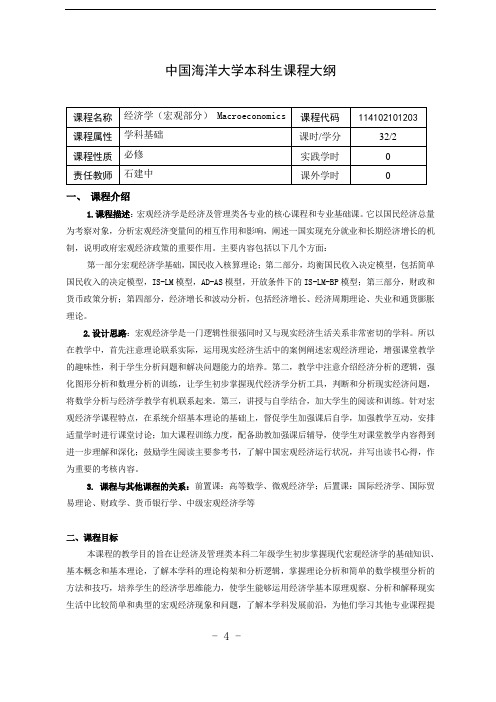
中国海洋大学本科生课程大纲一、课程介绍1.课程描述:宏观经济学是经济及管理类各专业的核心课程和专业基础课。
它以国民经济总量为考察对象,分析宏观经济变量间的相互作用和影响,阐述一国实现充分就业和长期经济增长的机制,说明政府宏观经济政策的重要作用。
主要内容包括以下几个方面:第一部分宏观经济学基础,国民收入核算理论;第二部分,均衡国民收入决定模型,包括简单国民收入的决定模型,IS-LM模型,AD-AS模型,开放条件下的IS-LM-BP模型;第三部分,财政和货币政策分析;第四部分,经济增长和波动分析,包括经济增长、经济周期理论、失业和通货膨胀理论。
2.设计思路:宏观经济学是一门逻辑性很强同时又与现实经济生活关系非常密切的学科。
所以在教学中,首先注意理论联系实际,运用现实经济生活中的案例阐述宏观经济理论,增强课堂教学的趣味性,利于学生分析问题和解决问题能力的培养。
第二,教学中注意介绍经济分析的逻辑,强化图形分析和数理分析的训练,让学生初步掌握现代经济学分析工具,判断和分析现实经济问题,将数学分析与经济学教学有机联系起来。
第三,讲授与自学结合,加大学生的阅读和训练。
针对宏观经济学课程特点,在系统介绍基本理论的基础上,督促学生加强课后自学,加强教学互动,安排适量学时进行课堂讨论;加大课程训练力度,配备助教加强课后辅导,使学生对课堂教学内容得到进一步理解和深化;鼓励学生阅读主要参考书,了解中国宏观经济运行状况,并写出读书心得,作为重要的考核内容。
3. 课程与其他课程的关系:前置课:高等数学、微观经济学;后置课:国际经济学、国际贸易理论、财政学、货币银行学、中级宏观经济学等二、课程目标本课程的教学目的旨在让经济及管理类本科二年级学生初步掌握现代宏观经济学的基础知识、基本概念和基本理论,了解本学科的理论构架和分析逻辑,掌握理论分析和简单的数学模型分析的方法和技巧,培养学生的经济学思维能力,使学生能够运用经济学基本原理观察、分析和解释现实生活中比较简单和典型的宏观经济现象和问题,了解本学科发展前沿,为他们学习其他专业课程提- 4 -供必要的基础理论知识和经济学思维能力。
宏观经济学术语(中英文对照)
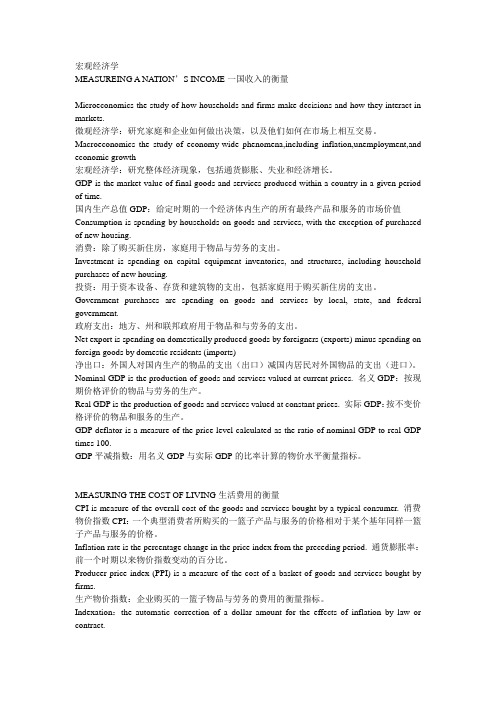
宏观经济学MEASUREING A NATION’S INCOME一国收入的衡量Microeconomics the study of how households and firms make decisions and how they interact in markets.微观经济学:研究家庭和企业如何做出决策,以及他们如何在市场上相互交易。
Macroeconomics the study of economy-wide phenomena,including inflation,unemployment,and economic growth宏观经济学:研究整体经济现象,包括通货膨胀、失业和经济增长。
GDP is the market value of final goods and services produced within a country in a given period of time.国内生产总值GDP:给定时期的一个经济体内生产的所有最终产品和服务的市场价值Consumption is spending by households on goods and services, with the exception of purchased of new housing.消费:除了购买新住房,家庭用于物品与劳务的支出。
Investment is spending on capital equipment inventories, and structures, including household purchases of new housing.投资:用于资本设备、存货和建筑物的支出,包括家庭用于购买新住房的支出。
Government purchases are spending on goods and services by local, state, and federal government.政府支出:地方、州和联邦政府用于物品和与劳务的支出。
- 1、下载文档前请自行甄别文档内容的完整性,平台不提供额外的编辑、内容补充、找答案等附加服务。
- 2、"仅部分预览"的文档,不可在线预览部分如存在完整性等问题,可反馈申请退款(可完整预览的文档不适用该条件!)。
- 3、如文档侵犯您的权益,请联系客服反馈,我们会尽快为您处理(人工客服工作时间:9:00-18:30)。
The open-economy versions of the IS and LM relations are: Ee IS: Y = C(Y − T ) + I (Y , i ) + G + NX Y , Y * , 1+ i − i* M LM : = YL(i ) P Changes in the interest rate affect the economy
Domestic Bonds Versus Foreign Bonds
In this part, we are studying the economy in the short run, so we can make two simplifications:
Both the domestic and the foreign price levels are given; thus, the nominal and the real exchange rate move together:
Macroeconomics, O. Blanchard 15
The interest-parity condition implies a negative relation between the domestic interest rate and the Ee exchange rate: i↑ ⇒ E ↓ E= 1 + i − i* i↓ ⇒ E ↑
Equilibrium in the goods market can be described by the following equations:
Equilibrium in goods market, financial market, and foreign exchange market
Y = C( Y - T ) + I( Y ,r ) + G - εIM ( Y ,ε ) + X ( Y * , ε ) ( + ) ( + ,− ) ( + ,− ) ( + ,+ ) Y = C( Y - T ) + I( Y ,r ) + G + NX ( Y ,Y * ,ε ) ( − , + ,+ ) ( + ) ( + ,− )
J. Ding, Nankai Univ.
Putting Goods and Financial Markets Together
Goods-market equilibrium implies that output depends, among other factors, on the interest rate and the exchange rate.
Macroeconomics, O. Blanchard
10
Putting Goods and Financial Markets Together
Putting Goods and Financial Markets Together
The IS curve is downward sloping. The LM curve is upward sloping. An increase in the interest rate reduces output both directly and indirectly (through the exchange rate).
The IS-LM Model in the Open Economy
directly through investment, and indirectly through the exchange rate
Macroeconomics, O. Blanchard 11 J. Ding, Nankai Univ. Macroeconomics, O. Blanchard 12
Y = C (Y − T ) + I (Y , i) + G + NX (Y , Y * , E )
( + ) ( + ,− ) ( − , + ,+ )
J. Ding, Nankai Univ. Macroeconomics, O. Blanchard 5
The domestic interest rate must be equal to the foreign interest rate plus the expected rate of depreciation of the domestic currency.
J. Ding, Nankai Univ.
The Effects of Policy in an Open Economy
An increase in government spending leads to an increase in output, an increase in the interest rate, and an appreciation
i=i + E
The current exchange rate is:
E= Ee 1+ i − i*
i↑ ⇒ E ↓ i↓ ⇒ E ↑
7
A monetary contraction, will cause the domestic interest rate to increase, and the demand for domestic bonds to rise. As investors switch from foreign currency to domestic currency, the domestic currency appreciates. The more the domestic currency appreciates, the more investors expect it to depreciate in the future. The initial domestic currency appreciation must be such that the expected future depreciation compensates for the increase in the domestic interest rate. When this is the case, investors are again indifferent and equilibrium prevails.
Macroeconomics, O. Blanchard
2
Output, the Interest Rate, and the Exchange Rate
Equilibrium in the Goods Market
The model developed in this part is an extension of the open economy IS-LM model, known as the MundellFleming model.
Lecture 14 The Open Economy (2)
Part III Output, Interest Rate, and Exchange Rate
J. Ding, Nankai Univ.
Macroeconomics, O. Blanchard
1
J. Ding, Nankai Univ.
Macroeconomics, O. Blanchard 8
J. Ding, Nankai Univ.
Macroeconomics, O. Blanchard
J. Ding, Nankai Univ.
Equilibrium in Financial Markets
The Relation Between the Interest Rate and the Exchange Rate Implied by Interest Parity
Central banks act under implicit and explicit exchange-rate targets and use monetary policy to achieve those targets. Some countries peg their currency to the dollar, to other currencies, or to a basket of currencies, with weights reflecting the composition of their trade.
Macroeconomics, O. Blanchard 6
J. Ding, Nankai Univ.
Equilibrium in Financial Markets
it = i * t +
Equilibrium in Financial Markets
E e t +1 − E t Et
Suppose the expected future exchange rate is given, then: Ee − E *
